Quality of the Environment in Japan 1994
(2) Complaints Related to the Blocking of Sunlight, Air Circulation, Light Pollution, etc.
The following is an examination of trends in complaints about types of pollution that fall outside the seven major categories ; these include the blocking of sunlight, interference with the reception of electromagnetic waves (largely TV transmissions), and poor air circulation. In fiscal 1992, there were 324 complaints related to the blocking of sunlight, which represents a year-on-year increase of 62. The number of such complaints surged from fiscal 1984 through 1987, when a peak of 846 complaints was registered. The following fiscal year the number of complaints fell by half; however, since fiscal 1989, the number has again been rising.
Turning to complaints related to interference with electromagnetic waves, in fiscal 1992 there were 536 such complaints, which represents a year-on-year decrease of 112. Having peaked once in fiscal 1978 at 475 complaints, the number declined gradually. From fiscal 1984 on, however, the number has again been rising, hovering between the 300 and 600 level a year.
Regarding complaints related to air circulation, in fiscal 1992 there were 12 such complaints, which represents a year-on-year increase of 9. Since reaching a peak of 70 such complaints in fiscal 1986, the number declined sharply and recently has been fluctuating (Figure 4-8-2).
Fig. 4-8-2 Trends in Complants about Types of Pollution that Fall Outside of the Seven Major Categories
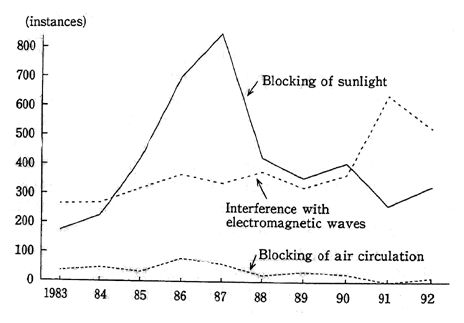
Source: Environment Agency
Fig. 4-8-3 Distribution of Brightness in the Night Sky over Japan
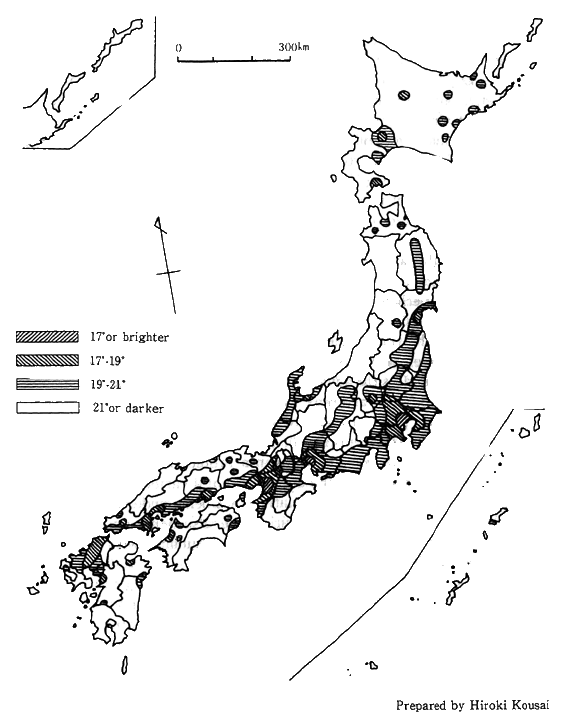
Source: Environment Agency
In fiscal 1992, there were 66 complaints related to light pollution. These included reflections from walls and excessive illumination late at night.
Light pollution caused by artificial light does not accumulate in the environment and does not have direct effects on human health the way that air and water pollution do. To the extent that it is perceived as unpleasant, light pollution, like that of noise, vibration, and offensive odors, differs greatly from the seven major types of pollution. According to "Star Watching Network," an event by the Environment Agency, the degree of light pollution of the night skies from street lighting and neon signs increases in step with the growth of cities, making it difficult to view the stars (refer to Figure 4-8-3).
At night, artificial lighting is essential to the preservation of the safety of roads and air routes and to the maintenance of critical urban functions. Nonetheless, nighttime illumination to an extent more than is needed is not only a step backward from an energy-saving perspective but obscures the view of the starry heavens, and thus implies the loss of a comfortable environment. In addition, it is feared, excessive nighttime illumination hinders the advance of astronomy by making astronomical observations difficult and may well affect ecosystems.
The first place in Japan to enact regulations against light pollution of the night sky was Bisei-cho (meaning literally "town of beautiful stars") Township in Oda-gun, Okayama Prefecture, in 1989. In addition to the establishment by public authorities of a variety of regulations to control outdoor illumination, initiatives are being undertaken by NGOs. Ordinances to prevent light pollution are also being enacted abroad, largely in the United States and Europe, beginning with Tucson, Arizona, in the United States.
Conclusion
Viewed from space, the earth is a planet covered with blue seas floating in the midst of black space. Without exception, astronauts returning from space speak of the spiritual message their experiences in viewing the planet have conveyed.
About one million years have passed since mankind first appeared on earth. We live in the present with history and culture marked by the aspirations and efforts of tens of thousands of generations our ancestors.
Japan is blessed with four beautiful seasons. Living their lives in peace, people all wish their descendants to live in peace, comfortable amid the changing seasons.
The environment of the earth, which makes these lives possible, is being threatened by such problems as global warming, due to an increase in carbon dioxide, a sharp decline in forests, and acid rain. The underlying causes of these problems gradually turn out to be human activities themselves. Many people begin to question whether mankind can continue living as it has been so far, consuming huge amounts of resources and energy and producing great amounts of waste. And it shows mankind is forced to make great changes in present-day attitudes and thinking patterns, and in lifestyles.
However, it will not be easy to change current lifestyles and customs. Moreover, it is not necessarily clear what kind of lifestyle and socioeconomic system will not destroy the environmental balance of the earth. The destruction of the environmental balance of the earth is not always what can be seen with the naked eye, nor can it be discerned as a pressing issue. Consequently, the uncertain future prevents us from taking well-planned countermeasures.
Nonetheless, given this situation, certain actions to change current socioeconomic patterns are emerging and gaining momentum.
For example,an international response was to hold the Earth Summit in June 1992, and a domestic response was to enact the Environment Basic Law in November 1993. These recognize that the earth's environment is finite and to be shared with future generations and that the industrialized and developing countries must meet each responsibility and make current socioeconomic systems sustainable in cooperation with each other in order to protect the earth's environment which is the basis of human existence common to everyone.
In response to the Summit and this law, a variety of activities are being undertaken. In Japan, pioneering efforts to put in place a sustainable socioeconomic structure that does not harm the environment are being made in various areas by many sectors of society including consumers and corporations.
In this report, an attempt has been made to outline, from an environmental perspective, Japan's current situation, centering on the consumer behavior that is thought to be key to an environment-oriented socioeconomic revolution as well as on the activities of the industrial community that will support this revolution. Also, an effort has been made to determine quantitatively, to the greatest possible extent, how much of a pollution load consumer behavior and particularly daily lifestyles put directly and indirectly on the local and global environment. Moreover, attitudes toward the preservation of the environment and actual case studies were examined, not only in the light of contemporary examples at home and abroad but also through discussion of historical examples.
These latter examples, taken from throughout mankind's long history, are not trivial. Rather they underscore the fact that seemingly innocuous socioeconomic and industrial activities undertaken in the industrialized countries have resulted and are resulting in particularly epochal consequences today. By the same token, a review of the teachings and customs of our ancestors shows that there is certainly nothing new about the idea of achieving a sustainable socioeconomic structure that is environment friendly ; many elements of this world view can be found in their teachings and precedents.
The question now is just what wide-ranging consequences are embedded in today's sociocultural and industrial activities.
As mentioned in the preface, since the dawn of history, mankind has consumed great amounts of resources and energy, and the pace of this consumption is rising at an unprecedented rate. Limits to this level of resource use are gradually becoming apparent, and it is becoming clear that current socioeconomic and industrial activities are causing environmental problems on a global scale that are difficult to perceive. There are various reasons for this.
First, it is difficult to comprehend the load individual lifestyles place on the environment because the ecological burdens posed by the goods and services used in daily life reach far beyond the immediate environment. Trade in goods and services is beneficial ; it enriches our daily lives and drives the expansion of the economy. Nonetheless, as one result of this development, people's daily lives have become separated from natural ecosystems, particularly in big cities where day-to-day activities are far removed from the production of such consumables as water, food, and energy. Through trade, the supplies of these things are closely connected to the world as a whole. Given today's complex socioeconomic structures, it is difficult to perceive the consequences individual consumption activities have on the environment.
Second, today's socioeconomic structures are based on the assumption of continued growth, and as a result we tend to give priority to growth. Therefore, when production and consumption taper off and economic growth stagnates as in the current business downturn, we seek to boost employment by quantitative economic expansion and by increasing incomes. Such objectives are almost automatic in today's society. Environmental problems tend to pale in contrast to the immediate problems associated with an economic downturn because most of the global environmental problems caused by socioeconomic activities do not emerge until after a substantial time lag. For example, the damage from warming due to excess atmospheric CO2 will not affect people today but future generations.
A comparison of the world of the past with that of today indicates that there have been extremely few maj or physical changes to the environment since historical records have been kept. Moreover, what changes there were tended to be limited in scope. For example, during Japan's Tokugawa period (1603-1867), society was fairly self-crontained both physically and in terms of energy use. At that time, the environmental impacts of man's activities were minimal, and the bounty provided by and threats posed by nature were perceived as local matters of immediate concern only to the people affected. In this type of society, the load placed on the environment by human activity tended to be self-limiting, and this kind of self-limiting behavior engendered its own rationality, which became enshrined in custom. The resultant socioeconomic structure may be viewed as environment friendly, incorporating capabilities for sustainability.
Today, the world is far different than it was in the Tokugawa period. People now enjoy relatively more freedom and physical wealth than they did then and harbor a far more diverse set of values. The question is how to reconfigure the contemporary socioeconomic structure to achieve a sustainable whole.
It is possible, as suggested previously, to elicit many instructive hints and lessons from the lifestyles of our ancestors. And encouraging seeds are sprouting here and there, amid a wave of new lifestyles, environment-friendly business activities, and the expanding operations of new environment-oriented businesses.
The transition to a sustainable environment-friendly socioeconomic structure will require us to revise our own attitudes and thinking patterns to adopt a more environment-friendly pattern and, moreover, will require great changes to today's mass-production, mass-consumption, mass-disposal oriented society.
Industrialized nations in particular will be expected to alter their focus on excessive production and consumption in favor of using goods for longer periods, of recycling resources as much as possible, and curtailing waste production. It is a mistake to view such changes as posing impediments to socioeconomic development or as leading necessarily to stagnation.
The wave of new lifestyles emerging steadily among consumers is definitely not forced. These lifestyles represent brave attempts, some of which will be doomed to encounter failure or difficulty, to explore the complex relationship between the environment and lifestyles. In short, these new lifestyles are self-motivated.
Similar lessons may be drawn from the activities of the industrial community and ecobusinesses, which are waking to assess new consumer trends and seeking out optimal ways to promote a sustainable socioeconomic structure. The new entrepreneurial spirit, driven by innovative concepts and technologies linked dynamically to the preservation of the environment and corporate survival and growth promises to change and invigorate society.
In this sense, the emergence of conflicts arising from consumers' search for new lifestyles and enterprises' search for new methods of production may well lead to the discovery of healthy, sustainable economic growth paths, prompted by changes to basic lifestyles that are environment friendly. At the same time, it should be pointed out that the recent economic downturn may well encourage new investment and consumption oriented toward environmental preservation. As was shown in Chapter 2, investment in the environment must not only protect the environment but promote the health of the economy in the long run.
In this, the role of government is to give thorough administrative consideration to environmental protection and to promote and channel the new wave of fresh thinking that is emerging. In other words, the role of government is to create a framework in which the various efforts made by social and corporate organizations can mesh creatively. A variety of issues require consideration. For example, the system through which accurate information on a range of environmental issues is provided needs to be reinforced. A framework needs to be created under which the costs of environmental protection can be appropriately assessed, the costs of producing more environment-friendly goods and services paid, and systematic long-term investments in the environment can be made.
Nowadays, given the increasing international socioeconomic interdependence, it is becoming more and more important to enlist the cooperation and coordination of the international community to properly resolve global environmental issues.
It is imperative to promote development based on the more effective, dynamic coordination of activities designed to further a sustainable socioeconomic structure including the government, the industrial community, citizens' groups, and local public bodies and that will encourage concrete actions by members of society. The Basic Environmental Program currently being formulated is expected to fulfil these functions.
The establishment of a society that can achieve sustained development while minimizing the load on the environment does not entail regressing to the arduous life of the Edo period. If people can cultivate their own wisdom and behavior to create a sustainable society in which all members of society apply global perspectives to their actions, life in such a society will be more splendid than ever and more rewarding.
Appendix
Names of Monitoring Stations (referred to in Volume 1, Chapter 4, Section 1: Current Environmental State of the Atmosphere) Keeping Watch on Trends in Major Air Pollutants
(Figures in square brackets [] indicate the number of monitoring stations.)
(Nitrogen Dioxide)
General Air Environment Monitoring Stations [15]
Ichihara city (nationally operated Ichihara monitoring station); metropolitan Tokyo (nationally operated monitoring stations in the following districts: Tokyo; Marunouchi in Chiyoda ward; Oshima in Edo ward; Omori Minami in Ota ward; Setagaya in Setagaya ward; Hikawa in Itabashi ward) ; Kawasaki city (nationally operated Kawasaki monitor); Nagoya city (nationally operated Nagoya monitoring station); Osaka city (nationally operated Osaka monitoring station) ; Amagasaki city (nationally operated Amagasaki monitoring station) ; Matsue city (nationally operated Matsue monitoring station); Kurashiki city (nationally operated Kurashiki monitoring station) ; Ube city (nationally operated Ube monitoring station) ; and Kitakyushu city (nationally operated Kitakyushu monitoring station)
Motor Vehicle Exhaust Monitoring Stations [21]
Chiba city (monitoring station at Chiba city hall) ; metropolitan Tokyo (monitoring stations in the following districts; Hibiya Yanagimachi; Kasugacho; Mukoujima; Kita Shinagawa; Omori; Kamiuma; Suginami; Ikebukuro; Umejima); Osaka city (monitors at the following locations: Yodoyabashi;Umedashindo ; Dekijima elementary school; Kitakohama elementary school); Yao city (monitoring station at Yao municipal hospital) ; Moriguchi city (monitoring station at Yadogawa vocational school) ;Hiroshima city (Kamiyacho monitoring station) ;Kitakyushu city (Miogino, Muromachicho, and Kurosaki monitoring stations) (Sulfur Dioxide)
General Air Environment Monitoring Stations [15]
Metropolitan Tokyo (monitoring stations in the following districts; Tokyo ; Marunouchi in Chiyoda ward ; Oshima in Edo ward; Omori Minami in Ota ward ; Setagaya in Setagaya ward ; Hikawa in Itabashi ward; Arakawa in Arakawa ward);
Yokohama city (monitoring stations at Kanagawa ward municipal headquarters, Kohoku ward municipal headquarters, Kasodai in Naka ward, Kanagawa Prefecture headquarters) ; Kawasaki city (monitoring stations at Daishi health care center ; pollution monitoring center ; Nakahara health care center) ; Yokkaichi city (at Isozu) ; Sakai (at Nishiki)
(Carbon Monoxide)
Motor Vehicle Exhaust Monitoring Stations [14]
Metropolitan Tokyo (monitoring stations in the following districts : Hibiya, Yanagimachi, Mukoujima, Kamiuma) ; Nagoya city (at Ryoshin building and Nagoya Mitsukoshi) ; Osaka city (monitoring stations at the following locations ; Umedashindo ; Dekijima elementary school ; Kitakohama elementary school) ; Kochi city (at Harimayabashi) ; Fukuoka city (at Tenjin) ; Kitakyushu city (at Miogino and Kurosaki monitoring stations) ; Saga city (at Katatae)
(Suspended Particulates)
General Air Environment Monitoring Stations [40]
Metropolitan Tokyo (nationally operated monitoring stations in the following districts ; Tokyo ; Omori Minami in Ota ward ; Setagaya in Setagaya ward ; Hikawa in Itabashi ward ; Shakujiidai in Nerima ward ; Nishikicho in Tachikawa city ; Higashiome in Ome city) ; Toyama Prefecture (monitoring stations at Toyama Shibaen, Toyama Iwase, Toyama Kureha, Takaoka Fushiki, Takaoka Tode, Shinminato Imai, Shinminato Ebie, Fuchurenjo, Omon) ; Kyoto city (at municipal headquarters, Minami, Kuga) ; Osaka-fu (nationally operated monitoring stations in the following districts : Osaka, Shorinji, Nishiki, Ishizu, Sanpo, Noda, Suita city fire dept.) ; Hyogo Prefecture (at Higashinada, Nada, Fukiai, Nagata, Suma, Tarumi) ; Tottori Prefecture (at sanitation research institute) ; Hiroshima Prefecture (at Kurenishi fire dept., dormitory of technical high school, Minami elementary school, Umida high school) ; Fukuoka Prefecture (nationally operated monitoring stations in Kitakyushu and at Wakamatsu observation station, Yahata observation station).
Names of Rivers and Streams Mentioned in Water Quality of Rivers and Streams (Volume 1, Chapter 4, Section 2 : 2Water Quality) Typical Urban Rivers and Streams
Shinkawa (Hokkaido) ; Arakawa (Saitama Prefecture) ; Edogawa (Chiba Prefecture, Tokyo municipality) ; Sumidagawa, Megurogawa, Kandagawa, Ayasegawa (all in Tokyo municipality) ; Tamagawa (Tokyo municipality and Kanagawa Prefecture) ; Ookagawa, Tsurumigawa (both in Kanagawa Prefecture) ; Shonaigawa, Horigawa, Nikkogawa (both in Aichi Prefecture) ; Kamogawa (Kyoto-fu) ; Yodogawa, Kanzakigawa, Tosaborigawa, Neyagawa (all in Osaka-fu) ; Yamatogawa (Nara Prefecture) ; Murasakigawa, Nakagawa (both in Fukuoka Prefecture).
Other Major Rivers
Ishikarigawa, Tokachigawa (both in Hokkaido) ; Iwakigawa (Aomori Prefecture) ; Kitakamigawa (Iwate Prefecture) ; Omomogawa (Akita Prefecture) ; Mogamnigawa (Yamagata Prefecture) Abukumagawa (Fukushima Prefecture) Nakagawa (Ibaraki Prefecture) ; Tonegawa (Gunma and Saitama Prefectures) ; Sagamigawa (Kanagawa Prefecture) ; Akanogawa (Niigata Prefecture) ; Jintsugawa (Toyama Prefecture) ; Kuzuryugawa (Fukui Prefecture) ; Shinanogawa (Nagano Prefecture) ; Tenryugawa (Shizuoka Prefecture) ; Yahagigawa (Aichi Prefecture) ; Kisogawa (Aichi and Gifu Prefectures) ; Yuragawa (Kyoto-fu) ; Kinokawa, Shingugawa (both in Wakayama Prefecture) ; Kakogawa (Hyogo Prefecture) ; Chiyogawa (Tottori Prefecture) ; Enokawa (Shimane Prefecture) ; Takahashigawa (Gkayama Prefecture) ; Otagawa (Hiroshima Prefecture) ; Yoshinogawa (Tokushima Prefecture) ; Watarigawa (Kochi Prefecture) ; Ohgagawa (Fukuoka Prefecture) ; Chikugogawa (Fukuoka and Saga Prefectures) ; Kumagawa (Kumamoto Prefecture) ; Onogawa (Oita Prefecture) ; Oyodogawa (Miyazaki Prefecture) ; Kawauchigawa (Kagoshima Prefecture).
Part II
Chapter 5. Promoting Comprehensive Environmental Administration
5-1 The Basic Environment Law
5-1-1 Background
Japan's administration of environmental affairs is carried out under the Basic Law for Environmental Pollution Control, enacted in 1967, and the Nature Conservation Law, enacted in 1972, both of which have played a significant role in preventing environmental pollution and conserving nature. However, the framework of the two laws, which center around regulatory measures, has become insufficient in responding to today's widening range of environmental problems, such as increased air pollution by nitrogen oxides, water contamination in closed water systems by domestic wastewater in large cities, the continuing increase of waste, global warming, ozone depletion, and other global issues. It is now necessary for corporations, industries, and all people as well as the State and local governments to tackle these issues voluntarily. It is also necessary to change both our current lifestyles and the prevailing economic system by utilizing a diversity of effective measures.
5-1-2 Summary of Deliberations in the National Diet
In consideration of the report Establishing a Basic Law of the Environment, submitted on October 20, 1992, by the Central Council for Environmental Pollution Control and the Nature Conservation Council, the Cabinet decided upon the Bill of the Basic Environment Law and the Bill of the Law Concerning the Enactment and Abolition of the Relevant Laws with the Enforcement of the Basic Environment Law on March 12, 1994, and presented them to the National Diet. These two bills were intended to provide a broad foundation for implementing a new, comprehensive environmental policy that would respond to the requirements of the era of the global environment
After approximately 34 hours of debate in the Lower House during the 126th session of the National Diet, the Cabinet bill was passed unanimously in the plenary session of the Lower House on May 20 with an article designating Environment Day appended to it. In the Upper House, after 24 hours of debate, another article, Cooperation among the State and Local Governments, was added and passed unanimously by the Environment Special Committee. However, because the Lower House was dissolved on June 18, the bill was abandoned before being enacted as law.
However, because the government was aware of the significance of enacting a law to provide for the realization of an environmentfriendly socioeconomic structure, and in deference to the deliberations in the 126th session, the bills, with articles added in the process of debate, were once again approved by the Cabinet and presented to the 128th session of the National Diet on September 28.
In that session, after 11 hours of debate in both Houses, the Cabinet bill was passed unanimously in the plenary session of the Upper House on November 12. Hence, the Basic Environment Law and the Law Concerning the Enactment and Abolition of the Relevant Laws with the Enforcement of the Basic Environment Law were officially announced and went into effect on November 19.
5-1-3 Outline of the Basic Environment Law
First, the Basic Environment Law states three fundamental principles for environmental conservation : the enjoyment and future success of environmental blessings, the creation of a society that can ensure sustainable development with reduced environmental loads, and the active promotion of global environment conservation through international cooperation. The law also clarifies the responsibilities of the State and local governments, corporations, and individuals for conserving the environment.
Second, in reference to policies promoting environmental conservation, the law, stating guidelines for the formulation and implementation of such policies, requires the State to establish the Basic Environment Plan and show people outlines of the policies. It also provides for environmental quality standards, environment pollution control programs, consideration in the formulation of policies by the State and other parties, and the promotion of environmental impact assessments. The Basic Environment Law also stipulates regulations and economic measures to prevent interference with environmental conservation. It promotes the construction and renovation of facilities related to conservation and the use of products contributing to the reduction of environmental loads. In addition, it includes education and learning on environmental conservation and measures to promote voluntary activities by private organizations, the promotion of science and technology, and international cooperation for global environmental conservation as well as cost-bearing and financial measures.
Third, the law stipulates the establishment of environment councils at the State and local levels and other related matters.
5-2 Conceptual Framework for Environmental Conservation Budgets and Related Matters
5-2-1 Outline of Budget and Treasury Investments and Loans
The budgets related to environmental conservation for fiscal 1993 reached a total of ¥1,730.4 billion, in terms of combining the totals in the General Account and each Special Account. This was an increase of ¥179.0 billion, or 11.5%, from the initial budget of ¥1,551.4 billion in fiscal 1992. Expenditures on pollution countermeasure projects came to ¥1,532.8 billion, and nature conservation-related expenditures came to ¥197.7 billion (see Table 5-2-1). Expenditures for pollution countermeasure projects by institutions to which treasury investments and loans were available came to ¥2,436.9 billion in the initial plans for fiscal 1993, which is an increase of ¥478.8 billion from the ¥1,958.1 billion earmarked in the initial plans for fiscal 1992. (These figures do not include environmental conservation project costs incurred by the institutions receiving such financial loans and grants but not specifying them.)
5-2-2 Budgets for Environmental Conservation
The budgets related to environmental conservation in fiscal 1993 were dispensed on a priority basis, particularly to set various standards, reinforce monitoring and control, promote pollution prevention projects in both the private and public sectors, undertake surveys and studies of pollution prevention, establish funds to assist those suffering from pollution, and promote measures to encourage the protection of nature. To realize the above, the following items were designated as key policy issues :
Table 5-2-1 Environment Conservation-Related Budgets by Ministry and Agency (Initial Budgets)
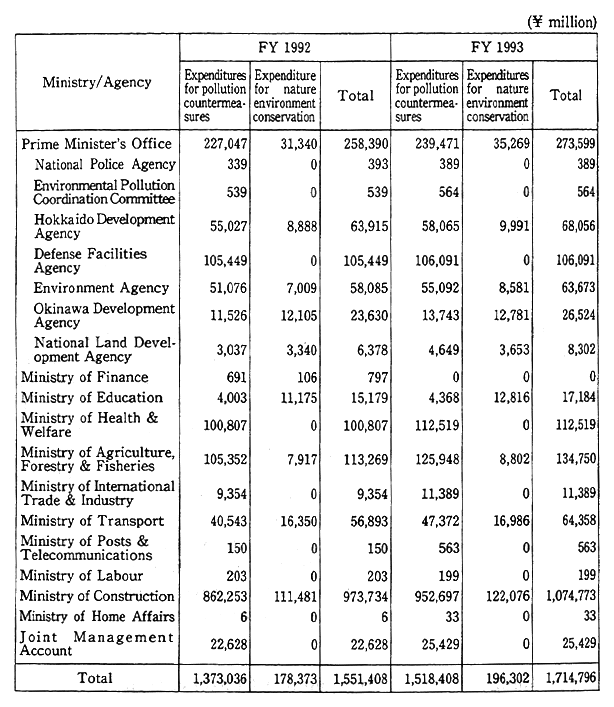
Notes:1. Survey conducted by the Environment Agency.
2. Expenditures allocated under implementation programs are subsidies payable at the time NTT project funds are repaid are excluded.
3. As figures are rounded, they do not necessarily add up to totals.
(1) Setting of Various Standards
¥1,268.0 million was earmarked for the setting of environmental quality and emission standards, which are fundamental to controlling atmospheric, water, and other forms of pollution.
(2) Strengthening Monitoring and Enforcement
¥6,233,890,000 was set aside for the monitoring and control of air, water, and other types of pollution. Major items included:
Facility costs for monitoring air and water pollution ¥828,850,000
Measures for insuring the safety of chemicals ¥1,026,550,000
Water pollution prevention measures ¥499,040,000
Air pollution prevention measures ¥330,440,000
(3) Subsidization of Environmental Pollution Prevention Projects
To encourage the installation of pollution prevention facilities by the private sector, an aggregate total of ¥10,413,600,000 was earmarked. Of this, expenditures associated with projects for construction and cession by the Japan Environment Corporation, totaling ¥4,638,710,000, and measures for the conservation of fishing grounds, totaling ¥1,395, 520,000, are the two main items.
(4) Promotion of Pollution-Related Public Works and Other Projects
For these types of public works projects, an aggregate of ¥1,412, 396,230,000 was earmarked. By category, the main items are as follows:
Sewerage Projects ¥982,186,000,000
Measures for noise prevention in schools, houses, etc., near public airports and defense facilities ¥138,723,240,000
Upgrading of waste treatment facilities ¥123,644,510,000
Farming village drainage ficilities ¥101,165,100,000
Measures against land subsidence ¥10,637,100,000
Green buffer zone projects ¥3,963,000,000
Construction to prevent mine pollution when mines are shut down or abandoned ¥3,170,210,000
(5) Undertaking Surveys and Studies of Environmental Pollution Prevention
To encourage surveys and studies on environmental conservation, a total of ¥32,449,920,000 was earmarked. By category, the main items are as follows:
Expenditures by the National Institute for Environment Studies ¥6,516,150,000
Tests and studies by national institutes on the prevention of environmental pollution ¥1,918,040,000
Comprehensive promotion of studies on the global environment ¥2,100,000,000
Study and development of new energy technologies ¥512,580,000
Grants-in-aid for scientific research expenses ¥783,000,000
(6) Establishing Funds to Assist Those Suffering from Environmental Pollution
For funds to assist those suffering from environmental pollution, a total of ¥25,212,270,000 was earmarked. By category, the main items are as follows:
Expenses, such as the payment of indemnities to sufferers ¥23,651,660,000
Costs for arbitration of pollution disputes ¥563,800,000
(7) Promotion Measures for Nature Protection
To work toward the conservation of the natural environment, ¥196,301,650,000 was earmarked. By category, the main items are as follows:
Costs for the management of national and quasi-national parks and for the development of facilities ¥8,338,150,000
Expenditures for park projects ¥133,179,750,000
Expenditures for projects to redevelop seacoasts, ports, and harbors ¥26,812,760,000
Outlays to purchase historic relics ¥11,393,110,000
(8) Other Issues
A number of other amounts were earmarked, including ¥4,531, 900,000 for such carbon dioxide countermeasures as fixation and effective utilization technologies, for a total of ¥30,520,180,000
5-2-3 Treasury Investments and Loans
Due to the recent strengthening of regulations in accordance with pollution prevention and control laws, it is becoming necessary for the private sector to increase investments in establishing pollution prevention and control facilities. Loans and grants from the treasury investments and loans are provided by government-related institutions, such as the Japan Environment Corporation, Japan Development Bank, Hokkaido and Tohoku Development Finance Corporation, Environmental Hygiene Finance Corporation, Smaller Business Promotion Corporation, People's Finance Corporation, Small Business Promotion Corporation, Agriculture, Forestry and Fishery Finance Corporation, Metal and Mining Industries Corporation, and Okinawa Development Finance Corporation, as subsidies to the private sector.
Loans and grants are also used to promote the improvement of sewerage projects, waste disposal facility construction projects, and other similar projects by local governments through local bond schemes.
5-2-4 Tax Measures Related to Loans and Subsidies for Environmental Pollution
(1) Subsidies Provided by the Japan Environment Corporation (JEC)
A. Activities of the JEC
The Environmental Pollution Control Service Corporation, the predecessor of the Japan Environment Corporation, was founded in October 1965 in accordance with the Law to resolve the serious air and water pollution that resulted from the strong economic growth from the late 1950s to the 1960s. Since then, it has functioned as a specialized promotion organization, providing environmental pollution countermeasure guidance to the private sector.
To comply with changes in environmental policies, the laws were revised in October 1992, leading to the expansion of the Corporation into a wider range of environmental conservation measures-for example, the maintenance of national and quasi-national parks-than its previous responsibilities of concentrating solely on environmental pollution prevention. Thus, it was renamed.
Furthermore, in accordance with a legal revision in May 1993, the Corporation established the Global Environment Fund to assist nongovernmental organizations (NGOs) in global environmental conservation activities.
(a) Construction and Cessions
The construction and cession projects of the JEC consist of (1) installing buildings for groups, (2) constructing facilities benefiting the public (green buffer zones and park facilities), (3) planting green zones to reduce air pollution, (4) building industrial waste treatment facilities and adjoining green buffer zones, and (5) constructing multiuse facilities at national and quasi-national parks. The Corporation oversees the construction and installation of facilities on behalf of private businesses and, upon completion, transfers the facility to the private sector under long,term, low interest repayment plans.
(b) Loans
The JEC advances funds for the following types of projects to parties undertaking their construction : (1) facilities for the prevention of industrial pollution, (2) disposal facilities for industrial waste, (3) projects to prevent soil pollution and the contamination of underground water sources in urban areas, and (4) funding for installation of combined septic tanks.
(c) Global Environment Conservation Programs
To tackle global environmental issues, the Corporation provides the following services : (1) information and technological know-how to organizations both inside and outside Japan to assist developing regions in conserving their environments, and (2) funds through the Global Environment Fund to NGOs conducting global environment conservation programs.
B. Projects in Fiscal 1993
New projects for fiscal 1993 were contracted at ¥100 billion, of which ¥63 billion was for construction and cession projects and ¥37 billion was for loan projects. An additional ¥1 billion was allocated to launch the Global Environment Fund project, and ¥500 million was secured as a subsidy for the Corporation.
(2) Loans by Other Government Institutions
A. Loans through Funding for the Modernization of Medium- and Small-Business Facilities
The Fund for Modernization of Medium- and Small-Business Facilities is based on the Medium- and Small-Businesses Modernization Funding and Other Subsidizing Methods Promotion Law and was established to promote the modernization of these businesses with funding provided to individual firms through prefectural governments. One part of this program consists of loans granted to construct pollution prevention facilities (specified in the circular), and, in fiscal 1993, these totaled ¥47.1 billion. For proprietors of small businesses, there is also a facilities-lending system through prefecturally established lending organizations ; its total budget for fiscal 1993 was ¥59.4 billion.
B. Loans by the Small Business Finance Corporation, People's Finance Corporation, and Okinawa Development Finance Corporation
In fiscal 1993, special loans were made for industrial pollution prevention facilities and factory transfers to reduce crowding and environmental pollution in cities through the Small Business Finance Corporation, People's Finance Corporation, and Okinawa Development Finance Corporation.
C. Loans by the Small and Medium-Sized Business Corporation
Under the Modernization Fund Scheme of the Small- and Medium-Sized Business Corporation, proprietors of small- and mediumsized businesses can obtain long-term, low-interest loans for projects that promote the structural modernization of their firms. Loans are provided for the relocation of facilities in industrial areas to eliminate combined residence-factory facilities and the construction of commonuse pollution prevention disposal facilities by small- and medium-sized businesses.
D. Loans by the Japan Development Bank
The Japan Development Bank extends loans for the modernization of pollution prevention facilities through established funding systems.
E. Loans by the Hokkaido and Tohoku Development Finance Corporation
The Hokkaido and Tohoku Development Finance Corporation extends loans to modernize pollution prevention facilities for reaching and maintaining the desired level of environmental conservation in the Hokkaido and Tohoku regions.
F. Loans by the Agriculture, Forestry and Fishery Finance Corporation
To prevent environmental pollution caused by stock breeding, while at the same time promoting higher productivity, the Agriculture, Forestry and Fishery Finance Corporation extends loans for the construction of livestock waste treatment facilities that are in accordance with regional needs and the degree of pollution. The fiscal 1993 budget was ¥1.4 billion.
G. Loans by the Metal and Mining Industries Corporation
Loans are extended for mining pollution prevention projects, including funding for wastewater treatment of closed or abandoned mines, in accordance with the Metal Mining Related Pollution Countermeasures Special Methods Law. Such loans may also be used as funding for the costs proprietors bear as specified in the Law Concerning Businesses' Bearing of the Cost of Public Pollution Control Works. The fiscal 1993 budget was ¥4.1 billion.
(3) Tax Measures
A. National Taxes
(a) The Japan Environment Corporation was newly added to the list of Specified Public Services Promotion Corporations after its establishment of the Global Environment Fund.
(b) Special depreciation measures adopted earlier as incentives for CFC emission control and collection facilities establishment were extended.
(c) For individuals or businesses selling land designated as a government managed area within the protected habitat of endangered species - based on the Endangered Species Protection Law-to the national or a local government, a special deduction of ¥15.0 million from the capital gains tax was approved.
(d) In accordance with the Special Law Concerning the Reduction of the Total Emission of Nitrogen Oxides from Automobiles in Designated Areas, if a small- or medium-sized business replaces an automobile that does not meet environmental standards used mainly in a designated area with a vehicle meeting the standards, the purchase will fall under the Energy Supply and Demand Structural Improvement Promotion Investment Taxation System, entitling the proprietor to apply for accelerated depreciation.
(e) The effective period for special depreciation measures applicable to such waste recycling facilities as can sorting and crushing equipment and foreign particle removers for treating glass particles was extended, while ink removal devices for recycled paper became subject to the Energy Supply and Demand Structural Improvement Promotion Investment Taxation System, which offers special tax reductions.
(f) The application period for special depreciation policies on pollution prevention facilities, including contaminated water treatment facilities, smoke emission treatment facilities, nitrogen oxide reduction facilities, and industrial waste treatment facilities, was extended.
(g) A tax deduction scheme under the special testing and research promotion taxation system was established for testing and research fees related to environmental development and other approved projects in accordance with the Temporary Special Measure Law on the Promotion of Business Programs Utilizing the Use of Energy and Recycling.
(h) A reserve fund was established to promote the use of recycled resources and will be applied to marketing costs for products manufactured from recycled resources or to the selective collection of approved recyclable resources by manufacturers, based on the Temporary Special Measure Law on the Promotion of Business Programs Utilizing the Use of Energy and Recycling.
B. Local Taxes
(a) In addition to extending the special tax reduction measures for property taxes on specified CFC emission control and collection facilities, trichloroethane emission control and collection facilities were made eligible for the same benefits.
(b) In accordance with the Special Law Concerning the Reduction of the Total Emission of Nitrogen Oxides from Automobiles in Designated Areas, if an owner replaces an automobile that does not meet environmental standards used mainly in a designated area with a vehicle meeting the standards, the purchase will become subject to the Energy Supply and Demand Structural Improvement Promotion Investment Taxation System, entitling the owner to apply for special depreciation.
(c) Vehicles meeting the 1994 nitrogen oxide exhaust standards will receive reductions in taxes payable under the Automobile Acquisition Tax.
(d) Reduction measures were adopted for the Automobile Acquisition Tax applicable to methanol vehicles.
(e) Application periods were extended for tax reductions to taxes payable under the Automobile Acquisition Tax for electric and light vehicles.
(f) Measures for reductions of the Business Establishment Tax were extended for facilities used by businesses operating as registered waste recycling agents.
(g) Measures adopted earlier to exempt facilities for converting water to industrial water from the Business Establishment Tax were extended.
5-2-5 Environmental Pollution Prevention Project Outlays Borne by Businesses
The Law Concerning Businesses' Bearing of the Cost of Public Pollution Control Works is applied to dredging projects, contaminated topsoil replacement projects, green buffer zone development projects, and other pollution prevention projects conducted by the national government or local public authorities; for each targeted pollution source, businesses are liable for all or part of the costs of the projects in proportion to their degree of responsibility for the pollution.
According to figures reported to the Environment Agency, through the end of 1993, the number of projects undertaken in accordance with this law since its enactment in May 1971 has been 100, and the total of pollution prevention project costs was approximately ¥270. 1 billion, while the total sum of costs paid by businesses was approximately ¥270.1 billion. On average, the business share of costs was 46.5% (Table 5-2-2).
Table 5-2-2 Shares of Pollution Prevention Project Costs Burne by Businesses
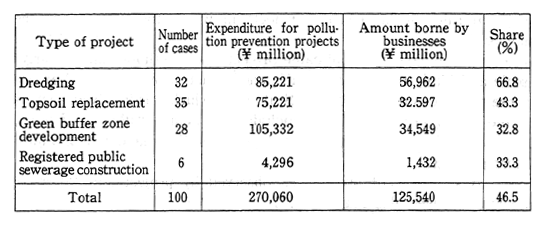
Notes: 1. Survey conducted by the Environment Agency.
2. The number of cases indicate the number of cost-bearing schemes that were approved; as there are cases where the projects are broken down into several schemes, the figures indicated here do not equal the actual number of cases undertaken.
3. As there are projects where both dredging and green buffer zone development were undertaken, the total number of cases does not necessarily equal the sum of the types.
4. The expenditures for pollution prevention projects and the total amount borne by businesses are calculated based on the plans for those projects that are incomplete. For compleoed projects, actual costs were used.
5-3 Environmental Impacts Assessment
5-3-1 Environmental Impacts Assessment
The environmental impact assessment is designed to make full surveys, predictions, and assessments in advance on. the possible environmental impact that may arise from the execution of projects release the findings; and listen to the views of community residents so that environmental conservation measures may be implemented to the full. It is an effective means to prevent environmental pollution.
In Japan, the environmental impact assessment has been performed under the Public Waters Reclamation Law and other individual laws, and administrative guidance has been performed by ministries and agencies and ordinances and operating procedures by local governments, etc., since the Cabinet approved "On the Environmental Conservation Measures Relating to Public Works "in June 1972.
Furthermore, the Cabinet approved "On the Implementation of Environmental Impact Assessment "in August 1984 and formulated the "Implementation Scheme for Environmental Impact Assessment "as a uniform rule for large-scale projects in which the State would be involved.
In summary, the applicable projects include those that are largescale and likely to produce significant impact, provided that they are those that are conducted by the State or in which it is involved, such as in the issuing of permits. They include roads, dams, railways, airports, land reclamation, and surface development, such as land zoning adjustment projects.
A summary of procedures observed by project-undertakers is given below (see also Figure 5-3-1):
A. In regard to the impact that is brought about by the projects, project-undertakers shall make prior surveys, estimate, and assess in accordance with the guidelines formulated upon consultation between the concerned ministers and the Director-General of the Environment Agency. They shall then come out with a preparatory draft environmental impact statement (hereinafter referred to as "draft EIS").
B. Project-undertakers shall serve public notice on and send out the draft EIS as well as hold briefings.
C. Project-undertakers strive to understand the views of residents. in the relevant areas on the draft EIS. They shall call on the governor of the affected prefecture to express their views after listening to the view of the mayor of the related municipality.
D. After listening to those views, project-undertakers shall review the descriptions contained in the draft EIS, prepare a final environmental impact statement (hereinafter referred to as "final EIS"), serve public notice on, and distribute the statement.
It is stipulated that administrative agencies shall take account of environmental impact on the final EIS in the licensing of subject pro-jects and other cases. It is also stipulated that the competent minister shall listen to the views of the Director-General of the Environment Agency, if deemed necessary.
Fig. 5-3-1 Flow of Procedures in the Outline for Implementation of Environmental Impact Assessment
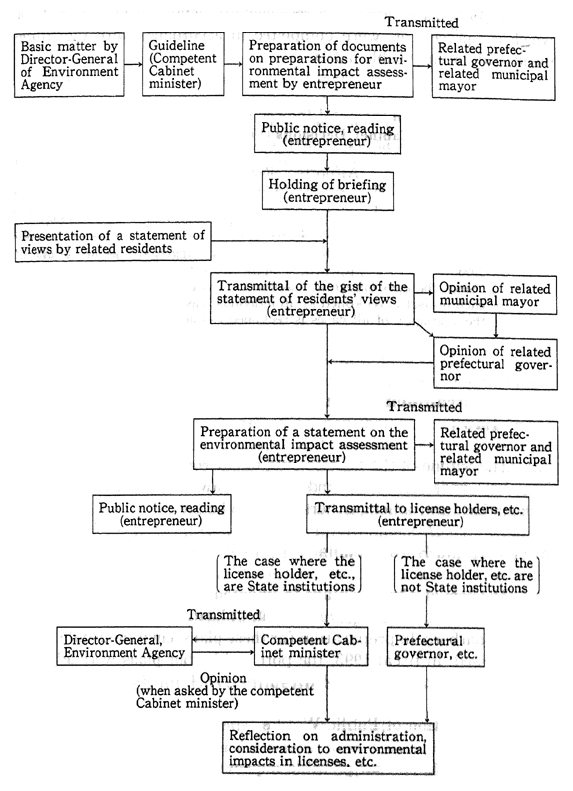
In 1993, there were 27 assessments of environmental impact for which the procedures were completed in accordance with the aforementioned outline (Table 5-3-1).
Table 5-3-1 Environmental Impact Assessments Made according to Cabinet Decisions (1993)

Notes: 1. The figures in parentheses represent the aggregates as of the end of 1993.
2. Since the environmental assessment was conducted in amalgamation, each project is reckoned as an individual case, and, as for a yearly sum, the aggregate of all cases is reckoned as one case.
5-3-2 Environmental Impact Assessments under Individual Laws
The outline of the assessments of environmental impact made in fiscal 1993 under the Port and Harbor Law and the Public Waters Reclamation Law, among others, is given below:
A. Port and Harbor Plans
The port and harbor plans formulated under the Port and Harbor Law are essential for the development, utilization, and conservation of ports and harbors. In preparation for these plans, environmental impact were assessed. In fiscal 1993, the port and harbor plans were adjusted based on their impact statement.
B. Reclamation of Public Waters
It is stipulated that possible impact on the environment shall be checked in advance of the licensing of reclamation under the Public Waters Reclamation Law. For reclamation in excess of 50 hectares and reclamation in need of special consideration to environmental conservation, it is stipulated that the competent minister must listen to the views of the Director-General of the Environment Agency. In fiscal 1993, there was no project for which the Director-General of the Environment Agency set forth his views.
C. Location of Power Generation Plants
For the location of power generation plants, environmental impact is assessed under the administrative guidance of the Ministry of International Trade & Industry, and during the course of deliberations at the Electric Sources Development Council, environmental conservation issues are also discussed based on the results of the environmental impact assessment. In fiscal 1993, the programs for the Tachibana Bay thermal power plant and Yanazu-Ookiri geothermal power plant, etc., were modified based on the impact statement.
D. Others
(1) City Planning for Urbanization Promotion Areas
With regard to city planning for urbanization promotion areas under the City Planning Law, it is stipulated that the views of the Director-General of the Environment Agency shall be sought in advance.
(2) In formulating basic concepts and implementing projects under the Comprehensive Resort Areas Development Law, it is stipulated that studies shall be made from the perspective of environmental conservation, depending on the substance, and that the competent minister shall discuss with the Director-General of the Environment Agency in approving of the basic concepts. Necessary adjustments were made to the basic concepts of Tokushima Prefecture, etc., in fiscal 1993. Necessary adjustments were made focusing on environmental conservation for other projects for which the Environment Agency was consulted.
5-3-3 Research on Environmental Impact Assessment
For future EIA systems, relevant ministries and agencies are jointly conducting comprehensive research on various EIA systems and the state of their implementation both in Japan and abroad. Based on the results of this research, the Government shall make necessary reconsiderations of the institutional framework of the EIA, which may possibly include future legislation. In fiscal 1993, investigation projects to study environmental impact assessment in countries other than Japan were launched.
Technical methods for environmental impact assessment have been steadily developed and refined over the years. In fiscal 1993, each relevant ministry and agency undertook research in this area.
5-3-4 Environmental Impact Assessment in Local Government
Local governments also have environmental impact assessment systems under ordinances or guidelines (Table 5-3-2).
Table 5-3-2 Enactment of Ordinances and Guidelines on Environmental Impact Assessments (December 31, 1993)
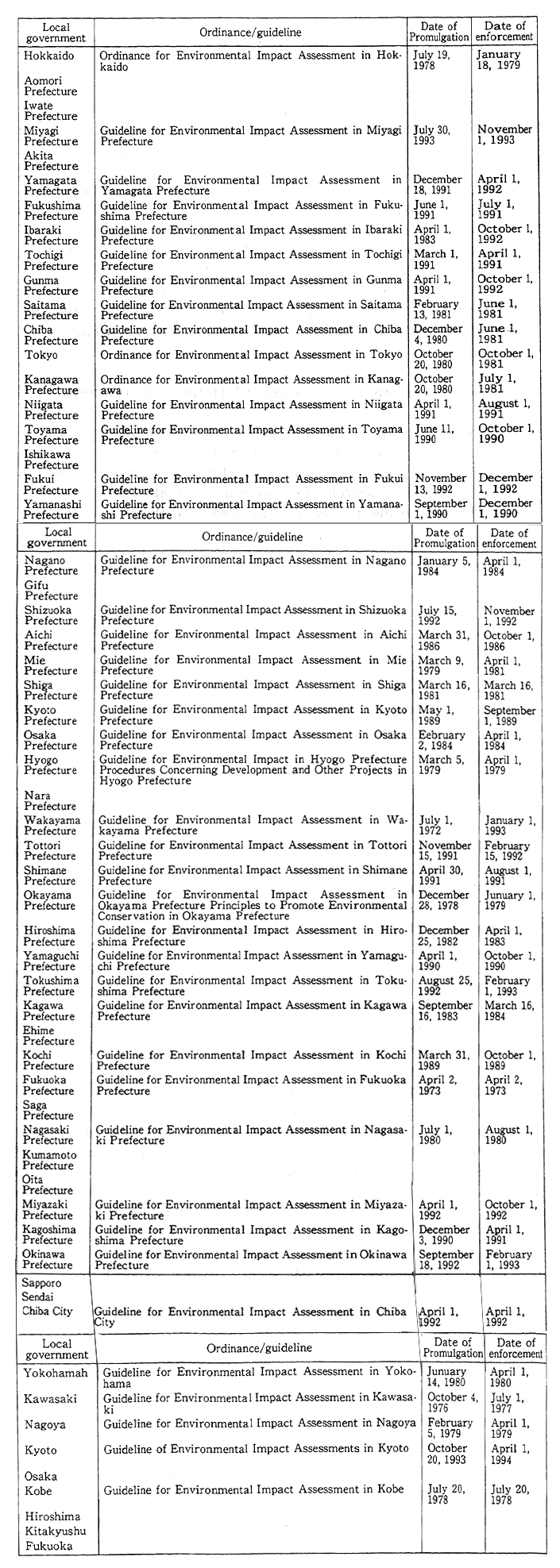
5-4 Promoting Regional Environmental Conservation
5-4-1 Promoting Environmental Management
(1) Future environmental policies must focus not only on pollution prevention, but also the conservation and proper use of water, air, soil, and forests in order to attain a more comfortable living environment.
To realize these goals, regional, natural, and socioeconomic conditions and the sentiments of local residents must be clearly understood. Policies must be enacted in a coordinated manner to meet regional needs when promoting regional environmental management.
Many large cities, including the Tokyo metropolitan area, continue to have low compliance levels regarding environmental conservation standards, while demand from residents for a more comfortable living environment continues to grow. Many large projects are still in the planning and development stages; hence, a need is rapidly arising for the promotion of broad-based environmental management.
(2) Several local public entities have recently begun research and investigation into specific methods for implementing regional environmental management. The Environment Agency is surveying the processes and procedures of these methods and providing guidance and advice to these local public entities to promote and expand their programs.
In addition, to adequately conserve and properly use regional environmental resources, aid has been provided to towns and cities preparing data on environmental resources and to those areas enacting Guidelines on Environmental Considerations for Regional Development, Environmental Resources in Hometowns Utilization Promotion Plans, and the Environmental Resources Conservation and Creation Plan.
(3) To respond to new problems arising in the regions, clear goals must be stated in each policy; hence, the preparation of a comprehensive regional environment indicator is essential.
For this purpose, the contents and problems of previous indicators were readjusted, while the outline of the comprehensive regional environment indicator and the main points to be covered were discussed.
(4) It is extremely important for all citizens to develop a deep understanding of environmental issues and adjust their lifestyles to embrace efforts that contribute to environmental conservation. In fiscal 1989, a fund for the conservation of the local environment was established in 58 prefectures and government ordinance-designated cities to fund continuous and effective educational programs to promote the awareness and understanding of environmental conservation issues. Programs consist mainly of the production of such awareness-raising promotional materials as videos and supplementary textbooks for schools along with the construction of a facility to serve as the center of regional environmental conservation efforts, the dispatching of environmental advisers, and other activities to support the efforts of regional citizens and autonomous groups by establishing a basis to implement environmental conservation programs. In addition, some public entities provide support for the implementation of environmental conservation programs by citizens' groups and others.
(5) As requirements grow for more intensive land use-especially in large cities-demand is rising for use of underground areas. This is especially true for areas not usually employed by land owners for such public purposes as railways, roads, and water pipes installed underground. Consequently, related ministries and agencies involved are now discussing the systematization of the use of underground space for such public purposes. There is concern that this use may result in land subsidence or affect hot spring water sources.
The Environment Agency inaugurated the Investigative Meeting Concerning the Environmental Management of Ground and Underground Development, a group of specialists who have been engaged in research and monitoring activities since 1988.
5-4-2 Promoting Comfortable and Environment - Friendly Regions
Abundant greenery, clean water, a beautiful urban environment, and historic atmosphere all contribute to a comfortable environment that enriches our everyday lives. As the demands from residents for a more comfortable living environment increase, conservation and pollution prevention alone are not sufficient. Strong efforts to create a comfortable environment are becoming increasingly necessary.
Specific measures that may be taken to enhance comfort through the environment are (1) maintaining and increasing the amount of greenery, water, and other natural environments that enable residents to enjoy nature, (2) conserving trees, waterfronts, and other attractive sights in the residents' immediate surroundings, (3) creating a scenic layout of streets and buildings in cities, (4) enacting measures to ensure that lifestyles and activities take environmental conservation into consideration, and (5) preserving historical and cultural sights to upgrade the quality of the environment. Thus, in order to create a comfortable environment, government, residents, and the private sector all must be aware of the extent of their responsibilities. Based on this awareness, policies to be determined must be suited to local communities; a direction must be set toward enhancing the quality of the environment; and such policies must be carried in a comprehensive and planned manner.
From this perspective, a symposium focusing on raising awareness throughout Japan to create a comfortable environment was held in October 1993, at which many examples of the activities undertaken by various regions were introduced. On this occasion, the fourth Awards for Local Public Entities Successful in Promoting the Realization of Towns with Amenity were presented to those organizations with impressive records in developing comfortable regional environments. In fiscal 1993, in designated model cities, work was begun on urban environmental programs to fully integrate urban environmental policies and on the promotion of municipal environment foundation construction promotion model projects, or Eco-City Construction Promotion Projects, for assisting in the construction of facilities based on specified priority projects of pending plans.
5-5 Promoting Pollution Prevention Programs
5-5-1 Outline of Pollution Prevention Programs
(1) Present Status of Pollution Prevention Programs
Heavily polluted areas are designated by the Prime Minister, based on Article 17 of the Basic Environment Law. Pollution prevention programs are created by the governors of the prefectures in which the designated areas are located and then approved by the Prime Minister.
According to the programs, businesses and local public entities are responsible for implementing pollution prevention projects.
Pollution prevention programs were drafted for nearly all large and major industrial cities between December 1970 and January 1977. After 1977, revisions to adapt plans to specific needs were made in 34 regions where the effective periods of their plans had expired (see Table 5-5-1 and Figure 5-5-1).
(2) Designated Regions for Pollution Prevention Programs
The areas formulated for pollution prevention programs include all large and major industrial cities throughout Japan. These areas account for approximately 9% of Japan's geographic area, 55% of the population, and 61% of the industrial output.
Table 5-5-1 Formulation of Pollution Prevention Programs
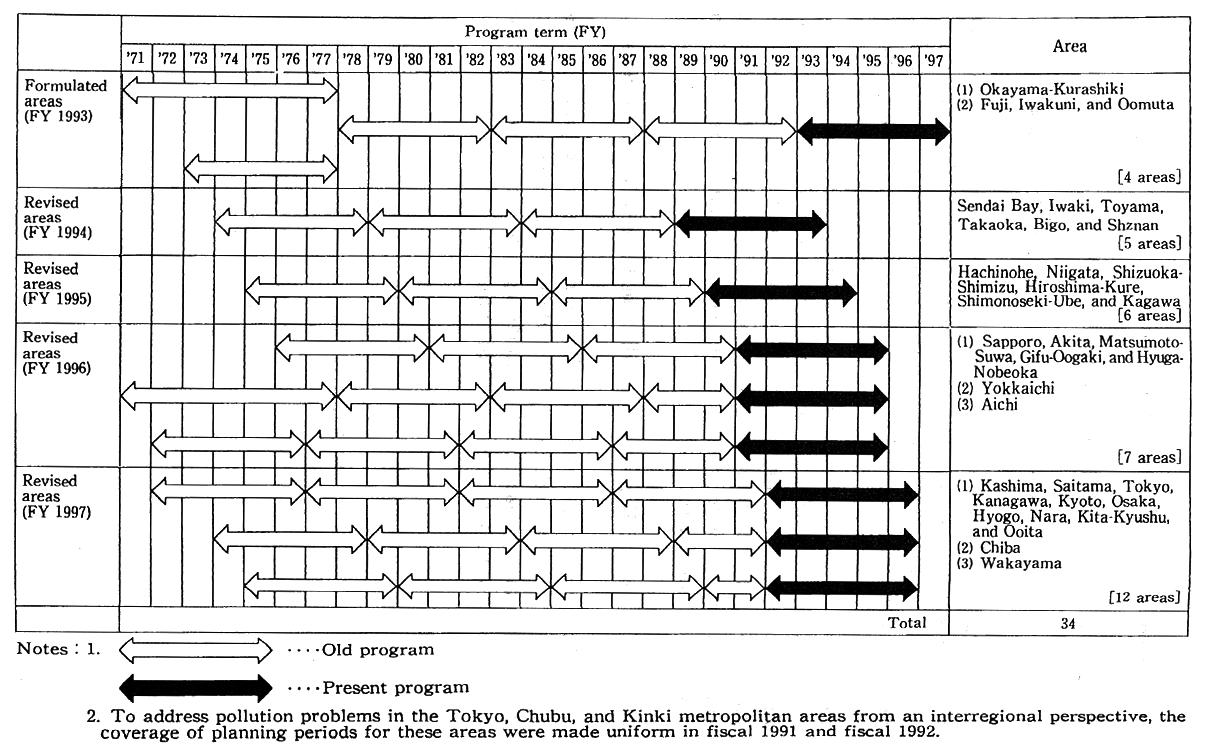
Notes: 1. Old program
Present program
2. To address pollution problems in the Tokyo, Chubu, and Kinki metropolitan areas from an interregional perspective, the coverage of planning periods for these areas were made uniform in fiscal 1991 and fiscal 1992.
Fig. 5-5-1 Areas with Pollution Prevention Programs Formulated (Present Programs)
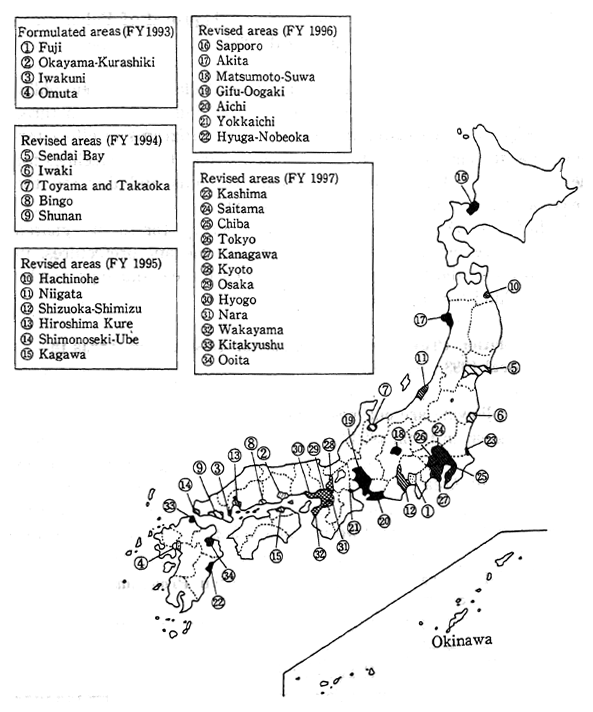
5-5-2 Formulation of Pollution Prevention Programs in Fiscal 1993
(1) Directives for the Formulation and Approval of Pollution Prevention Programs in Fiscal 1993
In September 1993, the Prime Minister declared that new pollution prevention programs were needed in the Fuji area and in three other designated areas after the period of the programs in effect terminated at the end of fiscal 1992. He then provided basic guidelines for the preparation of pollution prevention programs and directed the governor of each relevant prefecture to create such programs.
In fiscal 1993, pollution prevention programs for the designated areas were created by the governors of the relevant prefectures, in accordance with the guidelines provided for each area, and approved by the Prime Minister on March 7, 1994.
(2) Pollution Prevention Programs for Designated Areas in Fiscal 1993
The following are outlines of pollution prevention programs for designated areas in fiscal 1993 :
A. Scope of Area
The four areas are shown in Table 5-5-2.
Table 5-5-2 Areas with Pollution Prevention Programs and Their Scope
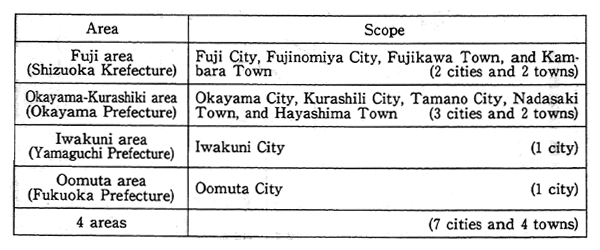
B. Goals
Goals of the programs include the establishment of environmental standards for air, water, and noise pollution, soil contamination, and other kinds of pollution. By promoting specific pollution prevention measures, efforts are being made to reach the goals in each category within the effective time period.
C. Time Period for the Plans
The effective time period for the plans is the five years from fiscal 1993 to 1997.
D. Pollution Prevention Measures
Businesses are to undertake measures to prevent air and water pollution. Local public entities are responsible for establishing specific regulations, undertaking environmental impact assessments, providing guidance on locations, ensuring the appropriate use of land, and overseeing measures for small- and medium-sized firms. They are also to supervise such pollution prevention projects as the maintenance of sewerage systems, green buffer zones, waste disposal facilities, school grounds, dredging, irrigation, and land reform as well as establish and maintain necessary inspection and monitoring systems. Additional projects to be implemented include the maintenance of parks and green zones and the enactment of traffic and land subsidence countermeasures, thus enabling the promotion of comprehensive programs.
E. Costs
Estimated costs for undertaking pollution prevention programs during the effective time period were ¥44 billion for businesses and ¥593 billion for local public entities, of which ¥460 billion was to be allocated for pollution prevention projects and ¥133 billion for pollution prevention-related projects.
Table 5-5-3 Implementation of Pollution Prevention Program Projects
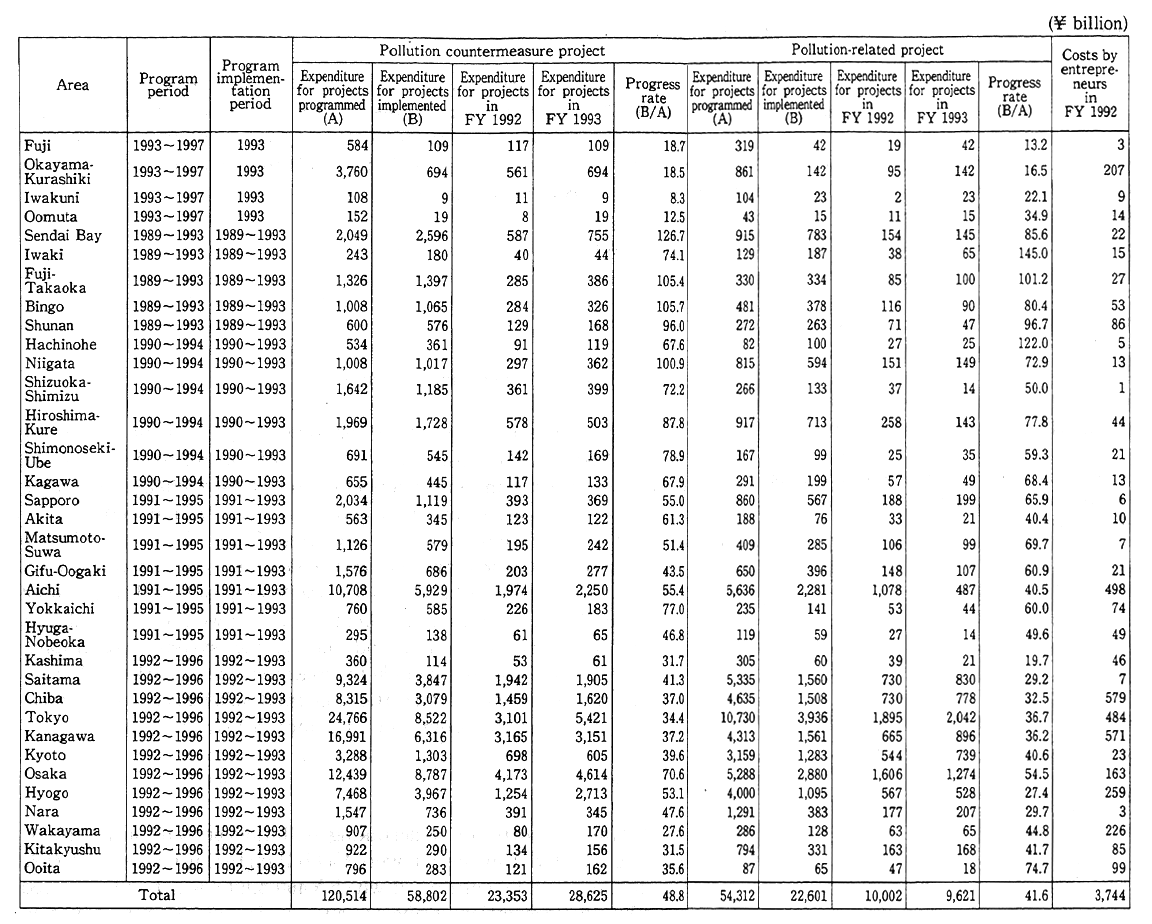
Notes: 1. Survey conducted by the Environment Agency
2. Pollution countermeasure porjects refer to prevent pollution and include the maintenance of sewerage facilities, green buffer zones, waste disposal facilities, school grounds, drainage facilities, irrigation systems, land reforms, monitoring and measurement systems, and others.
3. Pollution prevention-related projects refer to projects undertaken in relation to pollution prevention, including the maintenance of parks and greenery, traffic countermeasures, and land subsidence-related countermeasures.
4. Figures for fiscal 1992 are final, and those for fiscal 1993 are estimates.
5. Figures for each region may not equal totals, as figures are rounded.
5-5-3 Implementation of Pollution Prevention Program Projects
(1) Implementation of Pollution Prevention Program Projects
Local public entities implement integrated pollution prevention measures in accordance with pollution prevention programs. Record of implementation are shown in Table 5-5-3. In fiscal 1993, ¥2,862.5 billion was spent on pollution prevention programs and ¥962.1 billion on pollution prevention-related projects, for a total of ¥3,824.6 billion.
(2) Special Financial Measures Taken for Pollution Prevention Projects
To further promote pollution prevention measures, the national government paid or increased its share of subsidies-based on the Law Concerning Special Financial Measures for Pollution Prevention Projects-for pollution prevention projects undertaken by local public entities made possible through pollution prevention programs. Measures taken by the government to promote the implementation of pollution prevention measures included the expansion of project categories suitable for funding through local government bonds, and the inclusion of principal and interest redemption on local government bonds in the standard financial demand amount are additional special financial measures.
Pollution prevention project fees paid for in whole or in part by the government in the past five years are shown in Table 5-5-4. The amount of increase in fiscal 1993 was¥36.9 billion.
Table 5-5-4 Project Expenditure Associated with Pollution Prevention and State Burdens or Amounts of Subsidies Raised
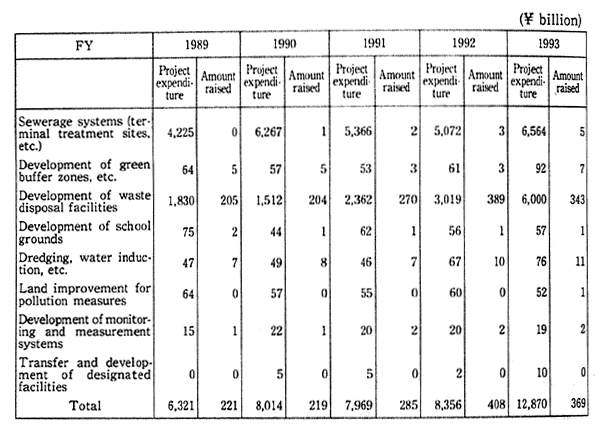
Notes: 1. Survey conducted by the Environment Agency
2. The amounts of the project expenditures and the amounts raised were those projected for FY 1993.
(3) Environmental Quality in Areas with Established Pollution Prevention Programs
The present status of pollution prevention programs in designated areas as a result of measures undertaken based on pollution prevention plans is as follows.
The percentage of monitoring stations meeting the long-term environmental evaluation standard (the number of monitoring stations that have met the standard/total number of effective monitoring stations) for sulfur dioxide in fiscal 1992 was 100%.
A review of countermeasures undertaken to comply with the environmental evaluation standard for sulfur dioxide is shown in Table5-5-5. In fiscal 1992, 4.5% of the monitoring stations registered figures exceeding the maximum environmental evaluation standard level of 0. 06ppm.
Table 5-5-5 Environmental Standards for Nitrogen Dioxide and Responses in Pollution Prevention Program Areas (General Stations)

Notes:1. Survey conducted by the Environment Agency.
2. Monitoring stations whose values are less than the effective monitoring hours have been excluded.
3. Zaltmann coefficient=0.84
A review of countermeasures undertaken to comply with the environmental evaluation standard for suspended particulate matter is shown in Table 5-5-6. In fiscal 1992, 31.0% of the monitoring stations were capable of meeting the standard.
Table 5-5-6 Compliance with Environmental Standards for Suspended Particulate Matter in Designated Regions (General Stations)

Notes:1. Survey conducted by the Environment Agency.
2. The monitoring stations that have not reached effective monitoring hours have been excluded.
Table 5-5-7 Achievement of Environmental Standards for Rivers, Lakes, and Ocean Areas in Pollution Prevention Program Areas (General Stations)
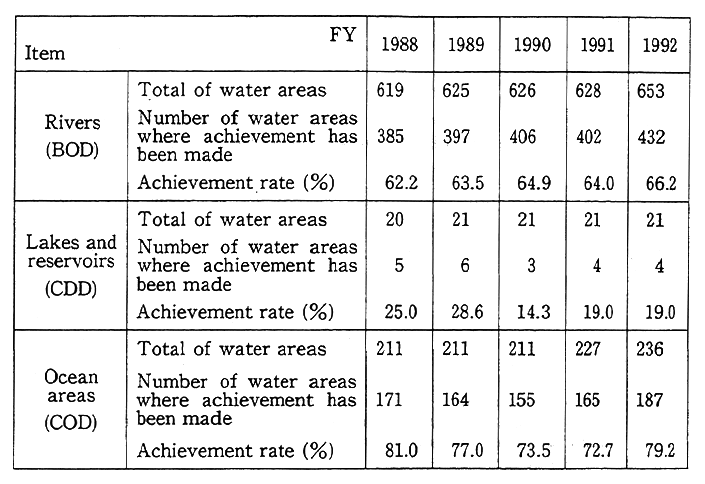
Table 5-5-8 Pollution Prevention Projects Designated by the Ministry of Home Affairs
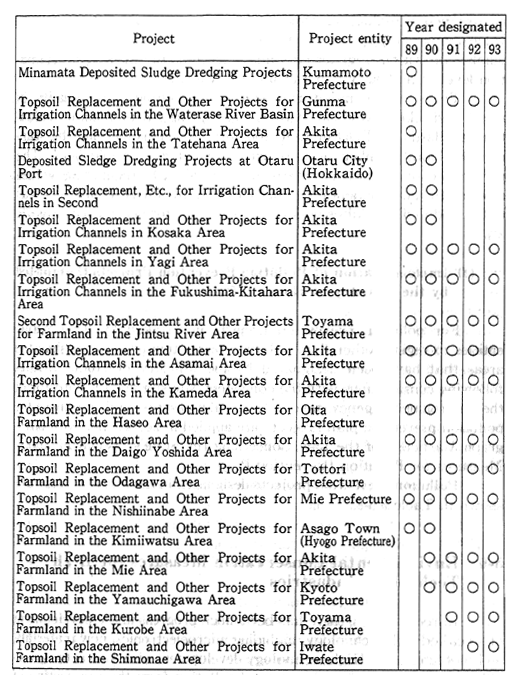
Note: By fiscal 1988, 42 projects had been completed.
The number of monitoring stations registering values meeting the environmental evaluation standard for photochemical oxidants (hourly value below 0.06ppm) in fiscal 1992 was 8 out of 687 stations. The number of stations registering values exceeding the warning proclamation level of an hourly value of 0.l2ppm was 311.
The status of monitoring stations measuring water quality in rivers and lakes registering values meeting the environmental evaluation standards for BOD or COD (number of regions meeting the standard/the total number of regions) is indicated in Table 5-5-7. The percentage of monitoring stations in fiscal 1992 registering values meeting the environmental evaluation standards for BOD in rivers was 64.0% and COD for lakes was 19%, while COD for ocean areas was 79. 2%.
(4) Implementation of Pollution Prevention Projects Designated by the Ministry of Home Affairs
For pollution prevention projects undertaken by local public entities in regions other than pollution prevention program designated areas that have been designated by the Ministry of Home Affairs following consultations with the competent Minister and the Director of the Environment Agency, special financial measures similar to those for pollution prevention plan projects are applied in accordance with paragraph 3 article 3 of the Law Concerning the State's Special Financial Measures for Pollution Prevention Projects.
Pollution prevention projects designated in the last five years are shown in Table 5-5-8.
5-6 Environmental Conservation Measures for High Technology Industries
In recent years, there has been much progress in the development of so-called high technology, including microelectronics, new materials, and biotechnology. High technology development also means the possibility of new types of environmental pollution from the perspective of emission sources, emission forms, and various impacts. In the industrial use of high technology, there is a need to intensively study possible environmental impact, thereby preventing environmental pollution beforehand, as well as apply achievements in high technology to issues of environmental conservation.
The Environment Agency published the Report of the Environmental Technology Council in April 1987, which laid out the basic direction for environmental conservation in dealing with the evolution of high technology. In addition, environmental technological information in the IC sector was released, and the Fact Finding Survey on the IC industry for fiscal 1986 was conducted under the cosponsorship of the Environment Agency, Ministry of Health & Welfare, Ministry of International Trade & Industry, and Ministry of Labour. Also, in the sector of new materials, a guidebook related to environmental protection for engineering plastics was published in December 1989.
As the industrial use of biotechnology has developed in recent years, studies are being performed domestically and abroad for the assurance of safety in industrial use.
In Japan, related ministries and agencies released guidelines for the industrial use of recombinant DNA technology, and recombinant DNA in closed systems has been developed. As for the release of recombinant DNA into the environment, field experiments are being performed in the United States and in other countries, and, in particular, the cultivation of recombinant plants are being performed in open environment. For the assurance of safety, the Science & Technology Agency amended the Operation of the Guidelines for Recombinant DNA Experiments in December 1988, thus presenting a concept for experiments in non-closed systems, with the use of plants, and on the basis of these guidelines, field experiments have been conducted. Also, on the basis of the guidelines set by the Ministry of Agriculture, Forestry & Fisheries, step-by-step safety considerations are made for the recombinant tomato in terms of ecological impacts and so forth in field experiments. Based on the findings in these experiments, a program for the cultivation of the recombinant tomato was approved in February 1992, and the cultivation of this tomato in open environment was begun in May 1992.
The Expert Committee on Biotechnology, which was established in the Planning Department of the Central Council for Environmental Pollution Control, completed its report and submitted it to the Planning Department in December 1991. It was pointed out in the report that it would be necessary to conduct an environmental assessment for each individual release program in relation to the environmental release of genetically modified organisms. On the basis of this report, the Environment Agency develops technical matters for environmental impact assessment and continues to study concrete administrative measures, while taking into account the evolution of scientific findings.
The Environment Agency has studied the monitoring of organisms, the application of biotechnology to environmental protection, and so on to cope with the environmental release of genetically modified organisms.
Also, the National Institute for Environmental Studies (NIES) performs research on plants that are highly sensitive to photochemical smog and other complex pollutants as a result of biotechnology and has installed the Facility for Microbial Culture Collection to preserve microbial genes that would be useful for environmental studies. In order to research application and the effect of genetically modified organisms, NIES established a Biotechnology Laboratory in October 1993.
The Ministry of International Trade & Industry and the Ministry of Agriculture, Forestry & Fisheries began such research on the applications of biotechnology in the field of environmental protection as environmentally conservative technologies for the production of hydrogen.
5-7 Safety Measures for Chemical Substances
5-7-1 Promoting Safety Related Policies for Chemical Substances
(1) The Law Concerning the Examination and Regulation of Manufacture, Etc., of Chemical Substances (hereinafter referred to as the Chemical Substances Control Law) was enacted in October 1973. In accordance with this law, new substances were submitted to inspection -called the pre-evaluation of new chemical substances-for low biodegradability, high bioaccumulativity, and chronic toxicity prior to their production or import. If new chemical substances came under all three categories, they were classified as Specified Chemical Substances and were subject to regulations on production, importing, and usage. The law was amended in May 1986, reclassifying the conventional Specified Chemical Substances as Class I Specified Chemical Substances and classifying substances with low biodegradability and suspected chronic toxicity but not high bioaccumulativity as Designated Chemical Substances. Steps are taken to monitor production volume and to conduct toxicity tests when health hazards may occur resulting from environmental pollution affecting a large area caused by certain Designated Chemical Substances. If the toxicity test results prove positive, the compounds are reclassified as Class II Specified Chemical Substances, obligating the manufacturer to comply with technical guidelines in handling the substances and provide labeling for environmental protection. These compounds are also subject to regulations on production and import when deemed necessary (see Figure 5-7-1).
Fig. 5-7-1 Regulations on Chemical Substances according to the Chemical Substances Control Law
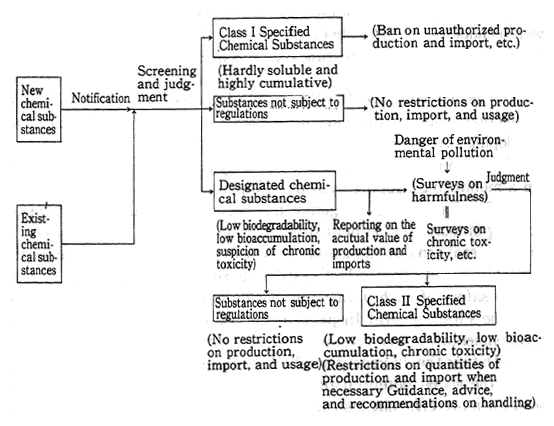
The notification of new chemical substances are submitted to the Minister of Health & Welfare and the Minister of International Trade & Industry. During 1993, notifications were submitted for 229 substances, of which 173 were not classified as Class I Specified Chemical Substances nor Designated Chemical Substances, and 41 were judged to be Designated Chemical Substances. As of the end of 1993, 122 substances out of all new chemical substances submitted were classified as Designated Chemical Substances. Furthermore, to investigate the safety of existing chemical substances, the Ministry of International Trade & Industry is conducting tests on the biodegradability and bioaccumulativeness of chemical substances and the Ministry of Health & Welfare on their chronic toxicity, while the Environment Agency is conducting surveys on concentrations of chemical substances in the environment. As of December 1993, 9 substances have been designated as Class I Specified Chemical Substances and 23 substances have been designated as Class II Specified Chemical Substances, while chloroform and other substances totaling 135 have been classified as Designated Chemical Substances.
(2) To investigate the safety of existing chemical substances, the Ministry of International Trade & Industry conducts tests on biodegradability and bioaccumulativity. As of the end of 1993, safety tests were conducted on 970 substances. In addition to conducting the tests, the development of new testing methods are under way to speed up the process.
The Ministry of Health & Welfare has been responsible for conducting tests on the chronic toxicity of chemical substances and developing effective toxicity tests. To reinforce safety monitoring of existing chemical substances, the Ministry is in the process of establishing a monitoring support system in Japan.
(3) The Environment Agency has been conducting research on the existing amount of chemical substances in the environment since fiscal 1974. Several tens of thousands of substances are said to be present in the environment. To conduct systematic research and effectively evaluate the safety of such a vast number of substances, the Agency undertook the First General Inspection Survey of Chemical Substances on Environmental Safety for the 10 years up through fiscal 1988.
During the 10-year period, changes in production activities, lifestyles, the rising potential of pollution from new technology, and the need for more efficient testing methods to keep in step with the pace of technological advance have made it necessary for the Agency to adopt new measures. In May 1988, the Central Pollution Countermeasures Council on the Environment and the Health Department Chemical Substances Expert Committee submitted suggestions on the future of the general inspection survey on environmental safety, which contained the following main points: (1) an expansion of the list of substances to be surveyed, (2) a selection of the substances to be tested through a thorough evaluation process called "Prediction of the Chemical Fate in the Environment,"and (3) the reinforcement of the content of the surveys by increasing the number of substances to be surveyed while shortening the survey period. Based on the Committee's suggestions, the Second General Inspection Survey of Chemical Substances on Environmental Safety began in 1989. The outline of the general inspection surveys is shown in Figure 5-7-2.
Fig. 5-7-2 Outline of the General Inspection Survey of Chemical Substances on Environmental Safety
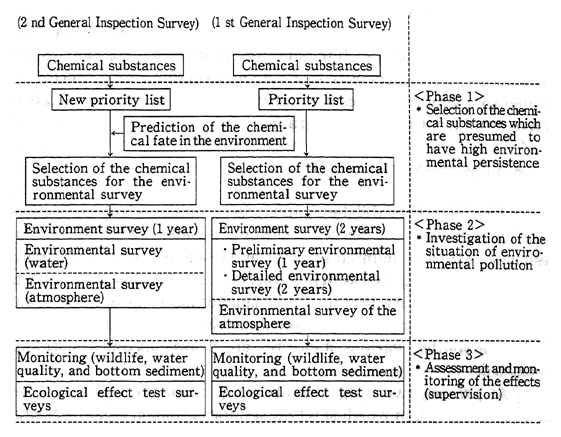
In fiscal 1993, environmental surveys, ecological effect test surveys, the monitoring of water and bottom sediment quality, and the monitoring of wildlife were conducted in accordance with the above outline on chemical substances.
As the usage of chemical substances increases, evaluation measures to assess the environmental risk of multiple chemical substances released into numerous environmental media through all phases of production and usage must be established, and existing systems must be reviewed to promote environmental conservation. Research and the organization of information on environmental chemical substances as well as research on and the evaluation of comprehensive countermeasures for occurrences of environmental pollution accidents are currently being conducted for this purpose.
(4) To address environmental pollution caused by chemical substances, in Japan, Europe, and the United States, laws have been enacted to require notification for safety evaluations conducted on new chemical substances prior to their production or import. In the United States, in order to minimize the impact of large-scale chemical compound accidents, a law was enacted to require factories to establish new emergency procedures and report the inventory of emission volume of toxic chemicals. International organizations such as the OECD, the World Health Organization (WHO), and the United Nations Environment Programme (UNEP) sponsor many active programs, as detailed below, related to countermeasures for chemical substances. Japan is also an active participant in these programs.
A. Programs of the OECD
The OECD establishes safety test guidelines to evaluate new chemical substances (Chemical Substances Safety Test Method) and designates MPDs (minimum pre-marketing sets of data), while promoting chemical hazard assessment projects. The OECD is also inspecting GLP (good laboratory practice), exchanging information, and examining the economic impact of chemical restrictions. Based on the results of these activities, various measures are drawn up and counseling is conducted.
At present, two programs are being carried out. One is a clearinghouse program, in which safety test information on existing chemical substances, which is collected and stored individually by each country, is distributed to member states. The other is a survey apportionment program in which member states are assigned to conduct safety tests on existing chemicals that are produced in large volumes worldwide, but little information is available on their safety. Furthermore, measures to reduce the risk of existing chemnical substances are being considered.
B. Programs of the WHO
Based on the approval by the WHO plenary session, and in cooperation with the UNEP and International Labor Organization (ILO), the International Programne on Chemical Safety (IPCS) is being implemented with the support of major research laboratories throughont the world. Under this plan, a system is being developed to evaluate the risk that high-priority chemical substances pose and their potential impact on health. Environmental health criteria are published quarterly for each chemical compound.
C. Programs of the UNEP
The UNEP collects and stores information on the effects that existing chemical substances have on health and the environment. It also manages the International Registry of Potentially Toxic Chemicals (IRPTC), which is conducted to distribute information on the regulatory aystems of member states. The UNEP also publishes data profiles, Provides a service for answering questions, and publishes the IRPTC Bulletin. The London Guidelines, which provide procedures for information exchange regarding the trade of banned or restricted chemical substances, also include the Prior Informed Consent (PlC) from the Country to which such substances are shipped.
Furthermore, by integrating the programs sponsored by these international organizations, Agenda 21, the action plan adopted the UNCED (United Nations Conference on Environment and Development) in June 1992, names the following areas as priority programs to be undertaken through global efforts aimed at "the environmentally sound management of chemicals, including the prevention of illegal international traffic in toxic and dangerous products." To conduct follow-ups on the items listed below, the International Conference on Chemical Safety (ICCS) was held in April 1994.
1. Expansion and acceleration of the international assessment of chemical risks
2. Harmonization of classification and labeling of chemicals
3. Information exchange on toxic chemicals and chemical risks
4. Establishment of risk-reduction programs
5. Strengthening of national capabilities and capacities for the management of chemicals
6. Prevention of illegal international traffic in toxic and dangerous products
7. Enhancement of international cooperation
(5) Responding to these global activities, ministries and agencies responsible are actively participating in the process of harmonizing chemical regulations within the OECD and are conducting inspections on the safety of high production volume chemicals. The reliability of test data is being enhanced while adjustments of domestic legislation are being undertaken to adapt the GLP approved by the OECD Council. Other activities under way are evaluations of the ecological effect assessment methods and the gathering and analysis of information on the safety of chemical substances in Japan and abroad.
Efforts to promote the use of the Material Safety Data Sheet (MSDS), which aims at facilitating information exchange among businesses concerning the safety of chemical substances, include issuing guidelines concerning the submission of information regarding the safety of chemical substances.
5-7-2 General Inspection Survey of Chemical Substances on Environmental Safety
(1) Environmental Surveys
In fiscal 1992, environmental surveys of water systems were conducted on water and bottom sediment in 55 areas and on fish in 50 areas throughout Japan. Of these, in 55 areas, inspections for benthiocarb were conducted as a priority substance ; in 54 areas, acetonitrile, acrylonitrile, and p-toluenesulfonamide were specified as priority inspection substances. Surveys for 13 other substances, such as dimethyl sulfoxide and o-toluenesulfonamide, were conducted in 10 to 28 areas.
Environment surveys of the atmosphere were conducted at 18 areas throughout Japan for 8 substances.
A. Environmental Surveys (Water Systems)
Of the 17 substances covered by the survey, 8 substances, including dimethyl suilfoxide and o-toluenesulfonamide, were detected in the water samples. Nine substances, including dimethyl sulfoxide and otoluenesulfonamide were detected in the bottom sediment, while dimethyl sulfoxide and isoprothiolane were detected in fish (Table 5-7-1). Evaluations of the test results are as follows:
(a) Dimethyl sulfoxide
This substance was detected with high frequency, especially in water and in bottom sediment. This result means that it is necessary to monitor the substance's concentration level in the environment. However, in the survey, the concentration detected in the water was relatively low, and in fish the detected figure was one digit larger. Such figures are not alarmingly high and do not suggest the need for immediate attention, but a follow-up environmental survey should be conducted after several years in order to determine the trend in the environment.
Table 5-7-1 Results of Environmental Survey (Water Systems) (Fiscal 1992)
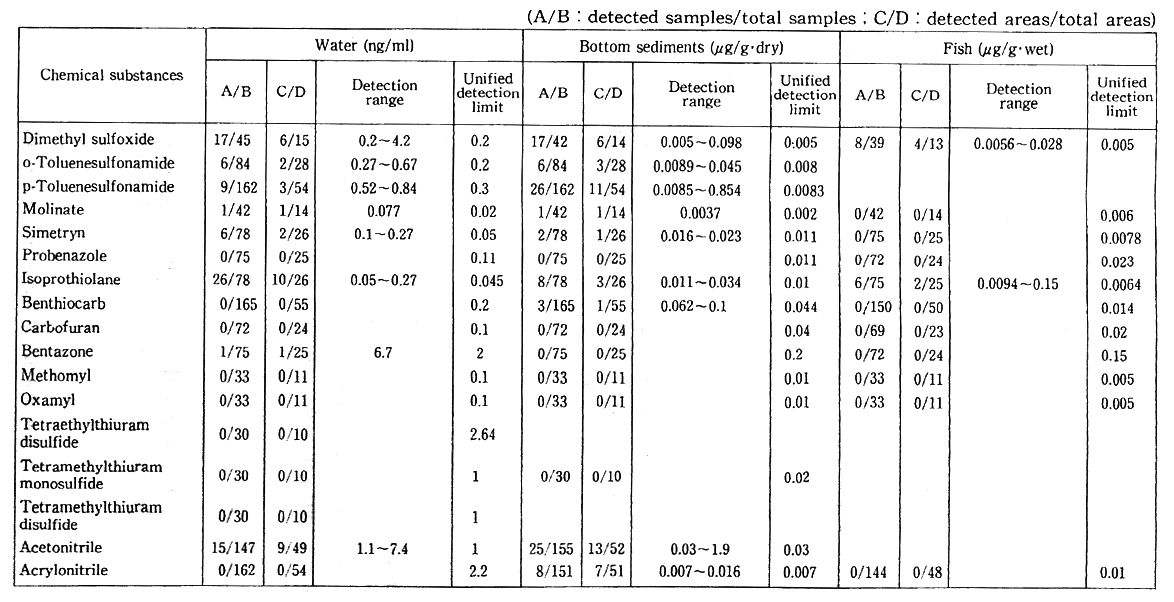
(A/B detected samples/total samples: C/D: detected areas/total areas)
Note : Figures in the total areas column are totals for those areas where data was available.
(b) o-Toluenesulfonamide and p-Toluenesulfonamide
These substances were detected in water and bottom sediment, but both the frequency and the concentrarion levels were relatively low, indicating that there is no need to take immediate action
(c) Molinate
Molinate was detected in both water and bottom sediment, but both the frequency and the concentration levels were relatively low, indicating that there is no need to take immediate action
(d)Simetryn
Simetryn was detected in both water and bottom sedeiment, As it is a weed kil1er, it is reported to have effects on some seaweed at low concentration levels, hence calling for attention to its exisiting concentration levels in the environment in the future. The results of the recently concluded survey show a low detection frequency, but continuous monitoring should be conducted in the future to determine trends, and research should be conducted on its effects on the ecosystem.
(e) Isoprothiolane
Detection frequency for isoprothiolane was especially high in water. It is one substance requiring continuous monitoring, However, the concentration survey data for and fish were relatively low, indicating that it is not an immediate high-priority substance. As isoprothiolane has been classified as a definite monitoring substance for water in March 1993, following those guidelines is enough for the time being.
(f) Benthiocarb
Benthiocarb was detected in bottom sediment ,but the detection frequency is low ; hence it does not call for immediate attention.
(g) Bentazone
Bentazone was detected in water, but both the detection frequency and concentration levels are low ; hence it does not call for immediate attention.
(h) Acetonitrile
Acetonitrile was detected in water and in bottom sediment, but the detected concentration level in water is low and the amount found in bottom sediment shows relatively small change from the previous survey ; hence it does not call for immediate attention,
(i) Acrylonitrile
Acrylonitrile was detected in bottom sediment, but its detection frequency was low and the detected concentration levels decreased from the previous survey ; hence immediate attention is not called for.
B. Environmental Survey (Atmosphere)
Two substances, carbon disulfide and benthiocarb, out of the 8 substances tested for, were detected. However, as the detection frequency for both suhstances was low, the emergence of new problems is not suggested (see Table 5-7-2).
Table 5-7-2 Results of Environmental Survey (Atmosphere) (FY l992)
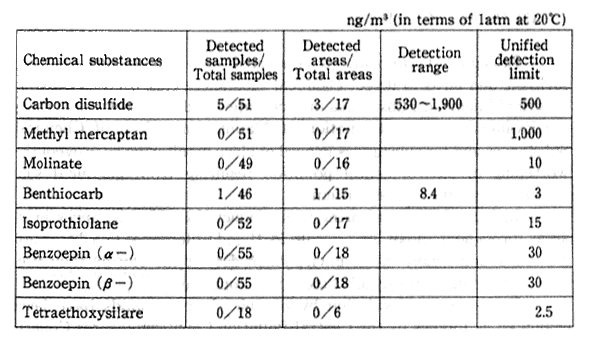
Note : Total areas iucludes only those ares where measurements were obtained.
(2) Outline of Water and Bottom Sediment Monitoring
Monitoring water and bottom sediment began as a part of the chemical substances environmental survey in fiscal 1986. This survey is conducted with a gas chromatograph/mass spectrometer (GC/MS), which can analyze many kinds of chemical substances simultaneously and accurately. Substances detected in the water and bottom sediment in the environment survey, especially Class I Specified Chemical Substances, are monitored over a long period of time with the GC/MS, and the yearly monitoring on environmental pollution is conducted through tracking the changes of the existing levels of the detected chemical substances.
In fiscal 1992, 20 substances in 18 areas throughout Japan were monitored. As a result, 7 substances, including b-HCH were detected in water, while all 20 substances were detected in bottom sediment. None of the substances were detected in water in the 4 areas. The number of substances detected in the other 14 areas were only 1 -5-a low total level. (see Table 5-7-3)
Detection levels in bottom sediment was higher as a whole in comparison with water, as over 5 substances were detected in 16 areas. In 9 of the 16 areas, over 11 substances were detected. The highest detection figures by substance suggest that in closed bays, high pollution levels were recorded.
(3) Outline of Biological Monitoring
Biological monitoring is conducted on animals such as fish, shellfish, and birds to detect chemical substances classified as Class I Specified Chemical Substances in accordance with the Law Concerning the Examination and Regulation of Manufacture, Etc., of Chemical Substances and for substances in need of close monitoring to prevent the worsening of environmental pollution resulting from chemical substances detected in the environment.
In fiscal 1992, monitoring was conducted on 30 substances in 20 areas throughout Japan. As a result, PCB and Chlordanes (5 substances) are still found widely in the environment despite the ban on their use. The monitoring of those substances will continue.
Environmental pollution by organic tin compounds have been evaluated as follows by the Central Pollution Countermeasures Council Environment and Health Department Chemical Substances Expert Committee, along with the inspection survey results for Designated Chemical Substances:
Table 5-7-3 Results of Monitoring Surveys of the Water and Bottom Sediment (Fiscal 1992)
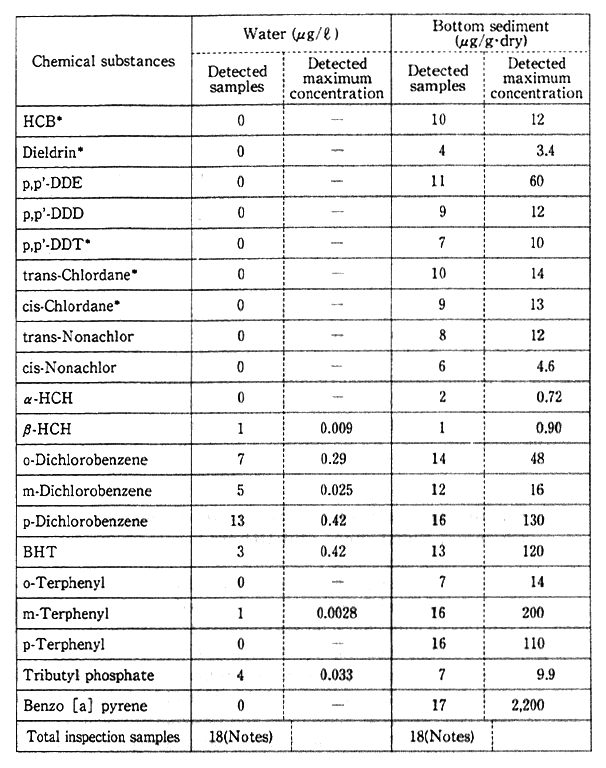
Notes:The total number of inspection samples for Tributyl phosphate is 17 for water and 15 for bottom sediment.
* Indicates substances classified as Class I Specified Chemical Substances Inspection samples for which measured values were not available are excluded from the total.
(Tributyl Tin Compounds)
Tributyl tin compounds are found widely in the environment, and their pollution levels showed signs of improvement in water ; however, in animals, where these compounds accumulate more easily, the figures were almost the same as before. The present pollution level is not an immediate danger, but a few high figures have been detected, indicating the need for continuing efforts to contain environmental pollution and monitor the pollution levels.
(Triphenyl Tin Compounds)
Triphenyl tin compounds, detected mainly in animals, are still widely spread in the environment. A few observations indicate high contamination levels, but signs of improvement have been seen. Considering the present production volume level of triphenyl tin compounds, pollution levels are expected to show further signs of improvement. However, continuous efforts to prevent pollution and monitor closely are still necessary.